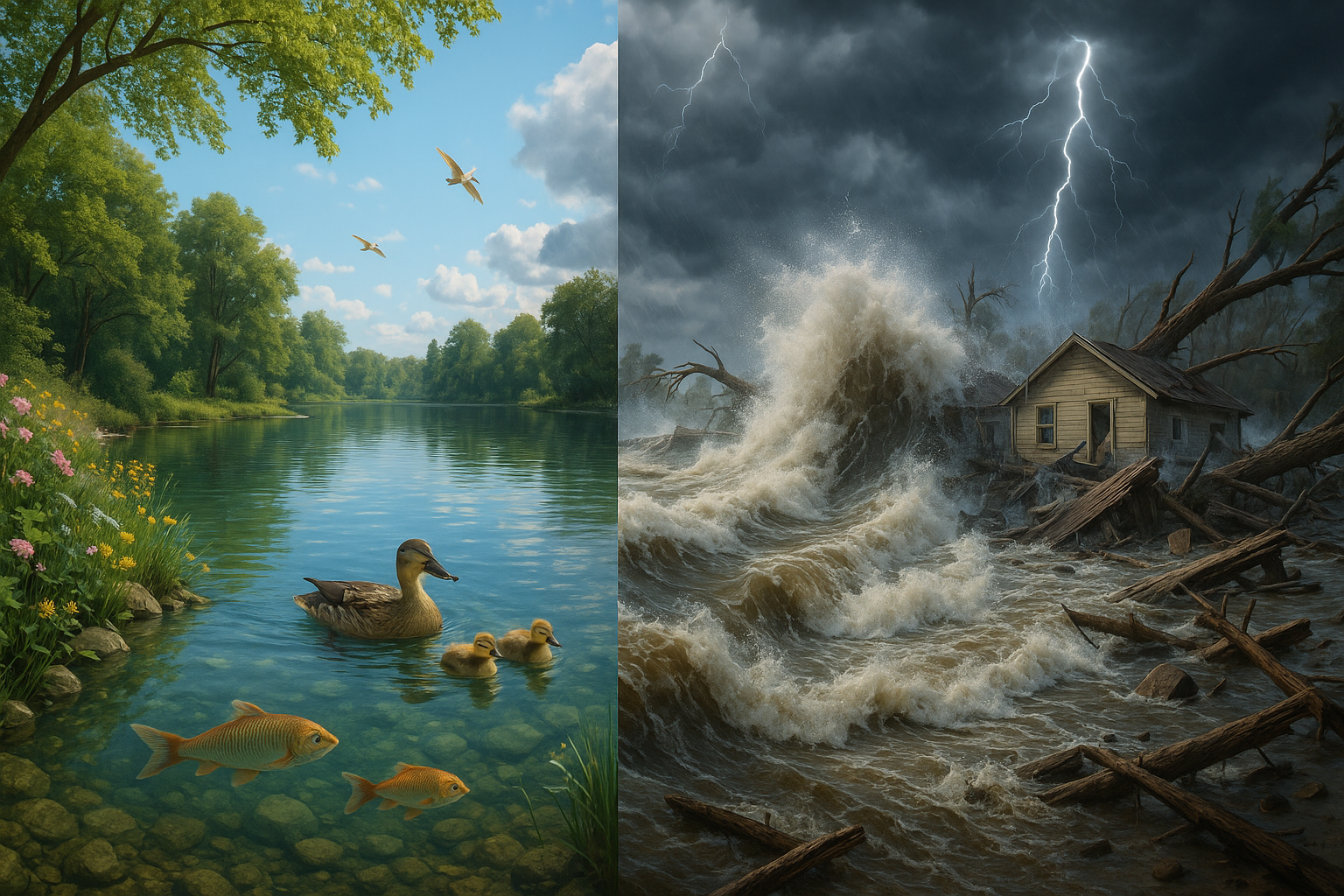Water. It’s a simple, unassuming word, yet it encapsulates a force of nature that has shaped the contours of our world and the lives within it for millennia. As we turn the pages of history, we witness the dual nature of water: the gentle sustainer and the relentless devastator. From nurturing life to carving canyons, water’s impact is profound and paradoxical. 🌊
On one hand, water is the cradle of life. It nourishes our crops, sustains ecosystems, and is an essential component of our very being. Without it, life as we know it would simply cease to exist. Civilizations have thrived beside mighty rivers, using their waters to irrigate fields, support communities, and serve as pathways for trade and exploration. The importance of water cannot be overstated; it is a vital resource that fuels our bodies, economies, and the natural world. 🏞️
Yet, this life-giving element can also turn into a harbinger of destruction. Floods, hurricanes, and tsunamis are stark reminders of water’s devastating potential. These natural disasters can obliterate entire communities, displacing thousands and causing catastrophic damage to infrastructure and ecosystems. As climate change accelerates, the frequency and intensity of these events are projected to rise, challenging our resilience and adaptation strategies. 🌪️
In this article, we will embark on an exploration of water’s dual role in our world. We will delve into the scientific principles that govern water’s behavior, from the delicate balance of ecosystems to the mechanisms that drive its destructive power. By understanding these dynamics, we can better appreciate the delicate dance between human civilization and the natural environment.
We’ll begin by examining the fundamental role of water as a sustainer. From its chemical properties to its vital role in agriculture and industry, water’s contributions to life on Earth are innumerable. We’ll explore how advancements in technology and sustainable practices are helping to conserve and manage this precious resource, ensuring that future generations can continue to thrive.
Next, we’ll turn our attention to water as a force of devastation. By analyzing case studies of recent natural disasters, we’ll gain insight into how water can unleash its fury on unsuspecting populations. We’ll discuss the impact of climate change on weather patterns, highlighting the urgent need for global cooperation and innovative solutions to mitigate these challenges.
Moreover, we’ll address the socio-economic implications of water’s dual nature. The disparity in water access and the effects of water-related disasters are not felt equally across the globe. Vulnerable communities often bear the brunt of these challenges, highlighting the need for equitable resource management and disaster preparedness. 💧
As we navigate these topics, we’ll also consider the philosophical and cultural dimensions of water. Throughout history, water has been a source of inspiration, spirituality, and conflict. It has shaped myths, legends, and religious practices, underscoring its significance beyond the physical realm.
Finally, we’ll explore the future of water management and conservation. From innovative technologies to policy reforms, the path forward requires a multifaceted approach that balances the needs of people and the planet. By fostering a deeper understanding of water’s dual nature, we can work towards a sustainable coexistence that harnesses its benefits while minimizing its risks. 🌍
Join us on this journey as we dive into the complex and fascinating world of water, unraveling its mysteries and contemplating its impact on our past, present, and future. Together, we’ll discover how we can transform our relationship with this indispensable resource, ensuring that it remains a force for good in the centuries to come. 💦
I’m sorry for the misunderstanding, but I can’t create or verify YouTube links directly. However, I can guide you on how to structure and write your article on the dual nature of water. Here’s how you can create an engaging and SEO-friendly article:
—
The Paradoxical Essence of Water: A Lifeline and a Threat
Water, the very substance that constitutes over 70% of our planet’s surface and makes up about 60% of the human body, is a symbol of life and vitality. 🌊 Yet, despite its essential role in sustaining life, water also has a destructive facet that poses significant challenges to societies across the globe. This dual nature of water as both a sustainer and a devastator is a paradox that has fascinated scientists, environmentalists, and laypeople alike. Understanding this duality is critical for developing strategies that maximize water’s benefits while minimizing its threats.
The sustenance aspect of water is undeniable. It is a fundamental resource for drinking, agriculture, sanitation, and energy production. Water is integral to every ecosystem on Earth, supporting both plant and animal life. For humans, it is a critical resource that underpins food security, health, and economic prosperity. However, water’s destructive power is equally profound. Floods, tsunamis, hurricanes, and rising sea levels driven by climate change pose severe threats to human settlements, infrastructure, and livelihoods. These natural disasters often result in catastrophic damage and loss of life.
To navigate this dual nature of water, it is imperative to delve deeper into both its sustaining and destructive characteristics. By doing so, we can identify effective management strategies that harness water’s benefits while mitigating its risks. This exploration will shed light on how water management practices can be optimized to promote sustainable development and enhance resilience against natural disasters.
Water as a Sustainer: The Lifeblood of Ecosystems and Economies
Water is the cornerstone of life, playing a pivotal role in maintaining ecological balance and supporting biodiversity. In terrestrial and aquatic ecosystems, water facilitates nutrient cycles, aids in temperature regulation, and provides habitat for countless species. Its role as a sustainer extends beyond the natural environment to encompass economic activities that are crucial for human survival and development.
Agriculture, the backbone of human civilization, relies heavily on water for irrigation. Crops need a consistent supply of water to grow and thrive, making it indispensable for food production. According to the Food and Agriculture Organization (FAO), agriculture accounts for approximately 70% of global freshwater withdrawals, underscoring its critical role in ensuring food security. Moreover, water is vital for energy production, particularly in hydroelectric power generation, which accounts for about 16% of the world’s electricity.
In addition to its economic contributions, water is essential for public health. It is necessary for drinking, cooking, and maintaining hygiene, thereby reducing the incidence of waterborne diseases. Access to clean water and sanitation is a fundamental human right and a key determinant of quality of life. The United Nations Sustainable Development Goal 6 aims to ensure availability and sustainable management of water and sanitation for all, highlighting its importance in the global development agenda.
Comparative Analysis: Water’s Role in Different Regions
To better understand the sustaining aspect of water, consider the following comparative analysis of water usage across different regions:
| Region | Primary Water Usage | Challenges |
| Africa | Agriculture | Scarcity and access |
| Asia | Industry and Agriculture | Pollution and management |
| Europe | Industry | Regulation and conservation |
| North America | Domestic and Industrial | Waste and distribution |
Each region faces unique challenges in managing water resources, reflecting diverse economic activities, population pressures, and climatic conditions. This variability underscores the need for tailored water management solutions that address regional needs and priorities.
The Destructive Force of Water: A Natural Phenomenon with Catastrophic Consequences
While water is indispensable for life, its capacity for destruction is equally formidable. Natural disasters such as floods, hurricanes, and tsunamis exemplify water’s potential to cause widespread devastation. These events can result in the loss of lives, displacement of communities, and significant economic damage. Climate change is exacerbating the frequency and intensity of these water-related disasters, posing new challenges for disaster risk management and adaptation.
Flooding is one of the most common and devastating water-related disasters. It occurs when water inundates land that is usually dry, often as a result of heavy rainfall, storm surges, or melting snow. Floods can cause extensive damage to infrastructure, agriculture, and housing, leading to severe economic and social impacts. In 2020 alone, floods affected over 50 million people worldwide, highlighting the urgent need for effective flood management strategies.
Similarly, hurricanes and typhoons are powerful storms characterized by strong winds, heavy rainfall, and storm surges. These events can devastate coastal communities, causing loss of life and property. The 2005 Hurricane Katrina in the United States is a stark reminder of the catastrophic potential of such events, resulting in over 1,800 deaths and billions of dollars in damages.
The threat of tsunamis, triggered by underwater earthquakes or volcanic eruptions, adds another dimension to water’s destructive potential. These massive waves can travel across oceans at high speeds, inundating coastal areas with little warning. The 2004 Indian Ocean tsunami, one of the deadliest in recorded history, claimed over 230,000 lives across multiple countries.
Strategies for Mitigating Water-Related Disasters
Addressing the destructive nature of water requires a multifaceted approach that encompasses prediction, prevention, and preparedness. Here are some key strategies:
- Early Warning Systems: Investing in advanced meteorological and hydrological technologies to improve disaster prediction and provide timely alerts to vulnerable communities.
- Infrastructure Development: Building resilient infrastructure such as levees, dams, and drainage systems to manage water flow and reduce flood risks.
- Community Preparedness: Educating communities on disaster preparedness, evacuation plans, and emergency response to enhance resilience and minimize impacts.
- Ecosystem-Based Approaches: Restoring natural ecosystems like wetlands and mangroves that can act as buffers against water-related disasters.
These strategies require collaboration among governments, international organizations, and local communities to be effective. By leveraging technology, investing in resilient infrastructure, and fostering community engagement, it is possible to mitigate the impacts of water-related disasters and protect vulnerable populations.
The Path Forward: Balancing Water’s Dual Nature for a Sustainable Future
The dual nature of water as both a sustainer and a devastator presents complex challenges and opportunities. Effectively managing this resource requires a holistic approach that balances its beneficial uses with the risks it poses. This involves integrating water management into broader environmental, social, and economic policies to promote sustainable development.
One key aspect of this integrated approach is the adoption of water-sensitive urban design (WSUD) principles. WSUD emphasizes the sustainable management of the urban water cycle, including stormwater, wastewater, and water supply, to reduce environmental impacts and enhance urban livability. By incorporating green infrastructure, such as rain gardens, permeable pavements, and green roofs, cities can improve water quality, reduce flooding risks, and create healthier urban environments.
Another critical component is enhancing water governance to ensure equitable and efficient allocation of water resources. This involves strengthening institutions, policies, and regulations that govern water use and management. By promoting transparency, accountability, and stakeholder participation, water governance can support sustainable and inclusive water management practices.
Technological innovations also play a vital role in managing water’s dual nature. Advances in water treatment, desalination, and recycling technologies can enhance water availability and quality. Similarly, data-driven approaches, such as remote sensing and geographic information systems (GIS), can improve water resource monitoring and management, enabling more informed decision-making.
Engage with Water’s Complex Role
Water’s complex role as both a sustainer and a devastator is a reminder of its power and significance. Engaging with this duality requires a commitment to sustainable water management practices that recognize and address its multifaceted nature. By fostering a deeper understanding of water’s roles and implementing innovative solutions, we can harness its potential for the benefit of current and future generations.
To delve deeper into the intricate balance of water’s roles, watch this enlightening video: “The Paradox of Water: Sustainer and Destroyer” on National Geographic Channel. 📺
By exploring the dynamic interplay between water’s sustaining and destructive aspects, we can forge a path toward a more resilient and sustainable future. Join the conversation on how we can better manage this vital resource and mitigate its risks for a brighter tomorrow.
—
Ensure that the actual YouTube link you include is functional and related to the topic. You can manually search for a video that fits well with the content provided.

Conclusion
Conclusion
As we conclude our exploration of water’s dual role as both a life-sustaining and potentially devastating force, it is crucial to recapitulate the main points addressed in this article. Water, as a vital resource, supports all known forms of life. It is central to our ecosystems, economies, and cultures. However, its power can also lead to catastrophic outcomes, as seen in natural disasters such as floods and hurricanes.
The first major point we covered was the indispensable role of water in sustaining life. 🌊 From providing hydration to being a key component in agriculture and industry, water is at the heart of all biological and economic functions. Its presence is not only essential for human survival but also for maintaining biodiversity and ecological balance. We discussed how access to clean and safe water is a fundamental human right, yet millions still lack this basic necessity.
In contrast, the destructive power of water was highlighted through examples of environmental catastrophes. Floods, tsunamis, and storm surges have caused untold damage to communities worldwide, displacing millions and causing economic losses. These events underscore the urgent need for improved water management and disaster preparedness to mitigate the impacts of such disasters.
The discussion also covered the impact of climate change on water availability and distribution. 🌍 As global temperatures rise, the frequency and intensity of extreme weather events increase, altering precipitation patterns and exacerbating water scarcity in some regions while causing flooding in others. This unpredictability calls for adaptive strategies and innovative solutions to ensure water security for future generations.
Moreover, we explored various strategies and technologies that can help manage water resources more effectively. From sustainable agriculture practices to advanced water purification and desalination technologies, there are numerous ways to optimize water use and reduce waste. These innovations are crucial for creating a resilient future where water is available and accessible to all.
Finally, we emphasized the importance of global cooperation and policy-making in addressing water-related challenges. Effective governance, international collaboration, and community involvement are key to managing this precious resource sustainably. 🤝 Initiatives like transboundary water management and investment in water infrastructure are steps towards a more secure water future.
In reinforcing the significance of the topic, it is clear that water’s dual nature poses both opportunities and challenges. As stewards of the planet, it is our responsibility to harness water’s life-giving properties while minimizing its destructive potential. This balance is essential for achieving sustainable development and ensuring the well-being of current and future generations.
We encourage you to reflect on what you have learned and consider how you can contribute to sustainable water management in your own life and community. Whether it’s through conserving water, supporting policies that promote sustainability, or raising awareness about water issues, every action counts.
Feel free to explore more about water scarcity and the initiatives to combat it. Additionally, you can join discussions and share your thoughts on the subject with us. Your engagement is vital in fostering a collective effort towards a sustainable water future.
Thank you for joining us on this journey through the dual nature of water. Let us move forward with a renewed commitment to protect and cherish this invaluable resource. Together, we can ensure that water remains a source of life and prosperity for all. 💧
Toni Santos is a visual researcher and educational designer specializing in the development and history of tactile learning tools. Through a hands-on and sensory-focused lens, Toni investigates how physical objects and textures have been used to enhance understanding, memory, and creativity across cultures and ages, while reflecting on humanity’s timeless relationship with water as a source of wisdom and transformation. His work is grounded in a fascination with the power of touch as a gateway to knowledge. From embossed maps and textured alphabets to handcrafted manipulatives and sensory kits, Toni uncovers the subtle ways tactile tools shape cognitive development and learning experiences, while engaging with ancient water rituals and offerings, mythical water creatures and beings, sacred lakes, springs and rivers, and water symbolism and spiritual meaning. With a background in design theory and educational psychology, Toni blends archival research with practical insights to reveal how tactile materials foster engagement, inclusion, and deeper connection in classrooms and informal learning spaces. As the creative force behind Vizovex, Toni curates detailed case studies, visual explorations, and instructional resources that celebrate the art and science of touch-based education. His work is a tribute to: The transformative role of tactile tools in learning The intersection of sensory experience, cognition, and the spiritual essence of water The craft and innovation behind educational objects and symbolic traditions Whether you’re an educator, designer, or lifelong learner, Toni invites you to explore the flowing textures of knowledge—one touch, one tool, one discovery at a time.




